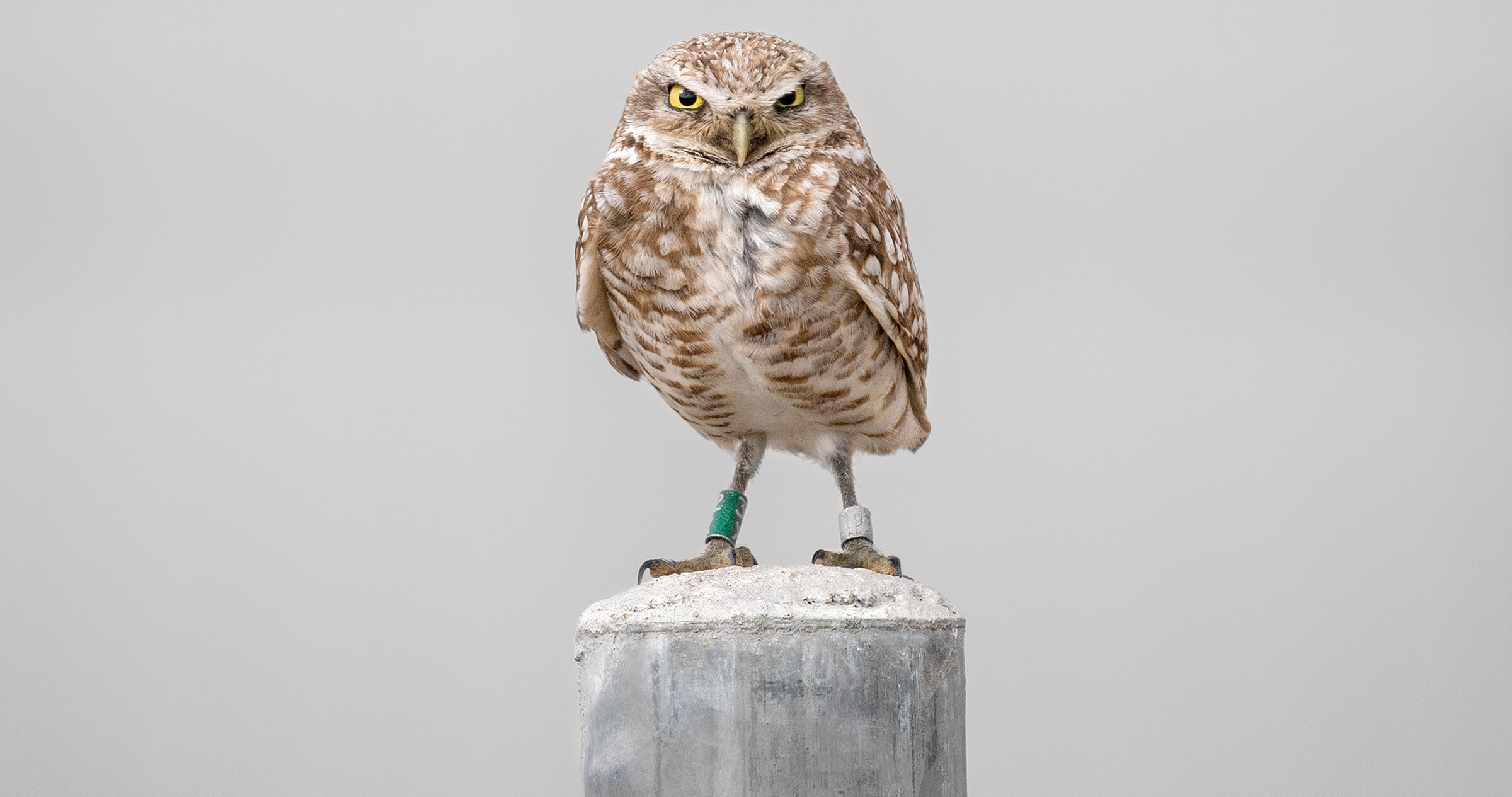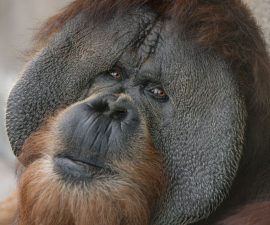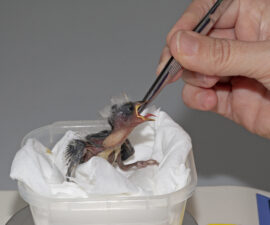BY Karyl Carmignani
Photography by Tammy Spratt
Even as the earth-leveling machines rumble nearby, the little owl stands its ground outside its burrow, golden eyes scanning the landscape for the flicker of moving insects or a mouse to nab for a meal. This underground raptor reuses burrows dug by other native species like ground squirrels, for roosting and raising chicks, and it helps keep insect and rodent populations in check. Despite this low-impact lifestyle, its penchant for open native grasslands throughout Southern California has put the western burrowing owl Athene cunicularia hypugaea on a collision course with humans, who often view its habitat as development opportunities.
Fortunately, this pencil-tall, dappled bird is getting some much-needed collaborative conservation attention. The San Diego Zoo Institute for Conservation Research Burrowing Owl Recovery Program is taking a multifaceted approach to helping mitigate the challenges these owls face across Southern California. Efforts include promoting annual maintenance in grasslands to reduce the density of the nonnative plant species, promoting native burrowing species while improving the use of artificial burrows for owls, owl relocation programs, tracking owls using GPS telemetry, and capturing owl behavior with hidden, motion-sensitive trail cameras. Recently, a volunteer citizen science project was unveiled on Zooniverse, which will help classify owl presence and activities in field photos that are posted online at Wildwatch Burrowing Owl. “It’s exciting to push this project out to a wider audience,” said Colleen Wisinski, conservation program specialist on the project. “Once people see the owls and get to know them, they will love them as much as we do!”
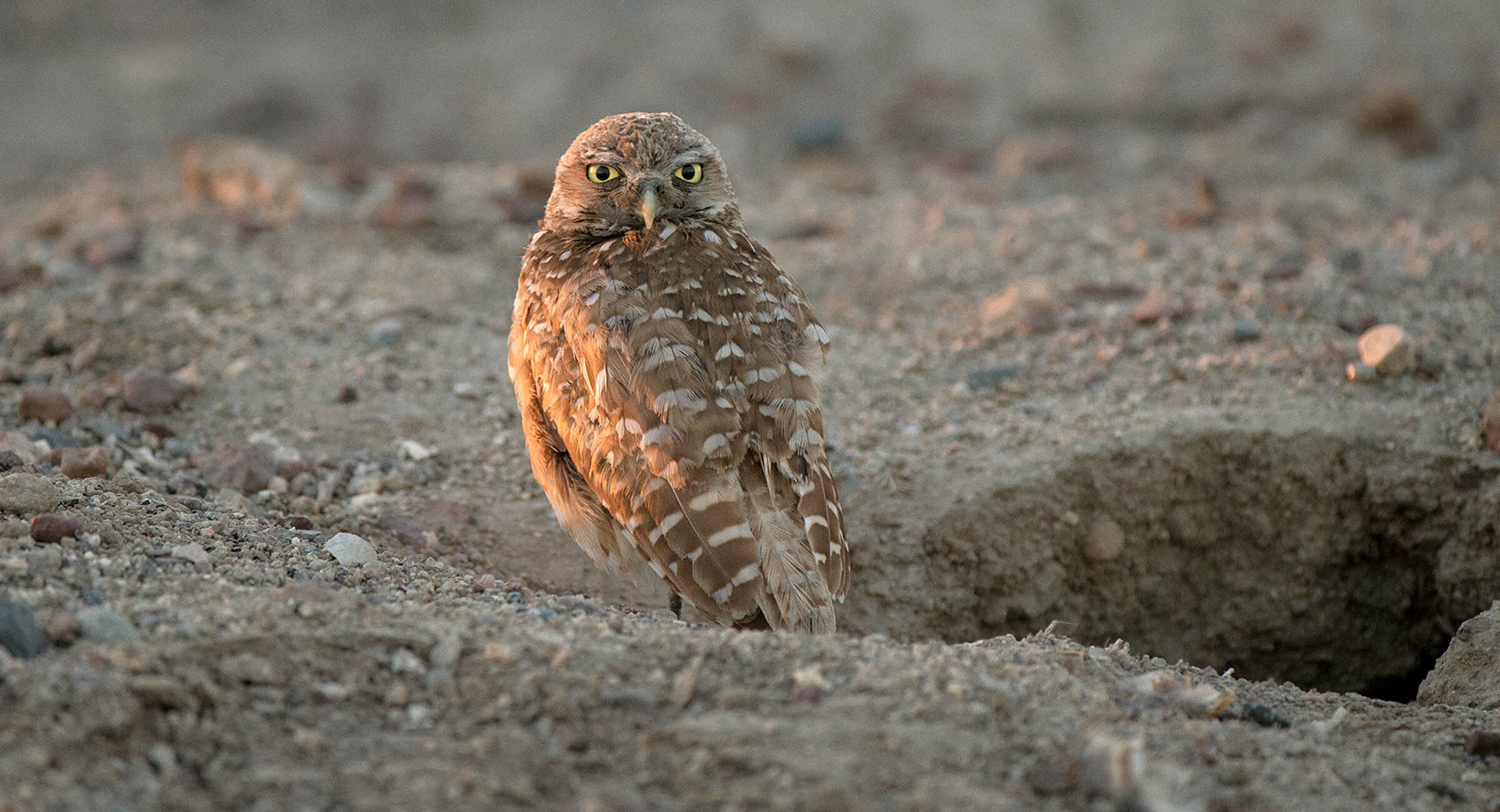
Moving On
Often the best way to save burrowing owls in the path of development is to relocate them to a protected area. Currently, there are two different translocation protocols: passive and active. “Passive relocation” entails excluding the birds from their burrow and hoping they will resettle in nearby natural or artificial burrows. “Active relocation” means that researchers collect the birds and move them to protected areas out of the way of development. However, the efficacy of these methods has not been comparatively evaluated…until now. Over the past three years, the outcomes of each protocol were compared across four counties in Southern California: Imperial, Riverside, San Bernardino, and San Diego. The goal is to identify best practice relocation strategies that land managers can employ. Part of the project involves several burrowing owls receiving tiny backpacks containing a GPS tracker, so researchers can keep tabs on them and learn more about the birds’ movement patterns, survival, and reproductive success in their new digs. “We are beginning to share results from our data with the burrowing owl community, to encourage more strategic use of relocation methods for conservation,” said Sarah McCullough Hennessy, Burrowing Owl Recovery Program researcher.

WATCHFUL AND ACTIVE
Burrowing owls are cathemeral, meaning they are active both by day and night. They fly close to the ground, hover, walk or run, and grab prey in their talons.
This past spring was extra wet, and the added rainfall that made for spectacular “super blooms” also bolstered nonnative plant growth. “The spring rains were a double-edged sword,” explained Colleen. “It supported a good prey base for the owls, but also caused the owl habitat to get overgrown, making it an unsuitable nesting area. We did a lot of weed-whacking to get the vegetation lower.” She said that in one colony with 15 to 18 nests early on, only 4 remained after the rains. But more than 10 pairs returned to the site after they treated the landscape. Hooray!
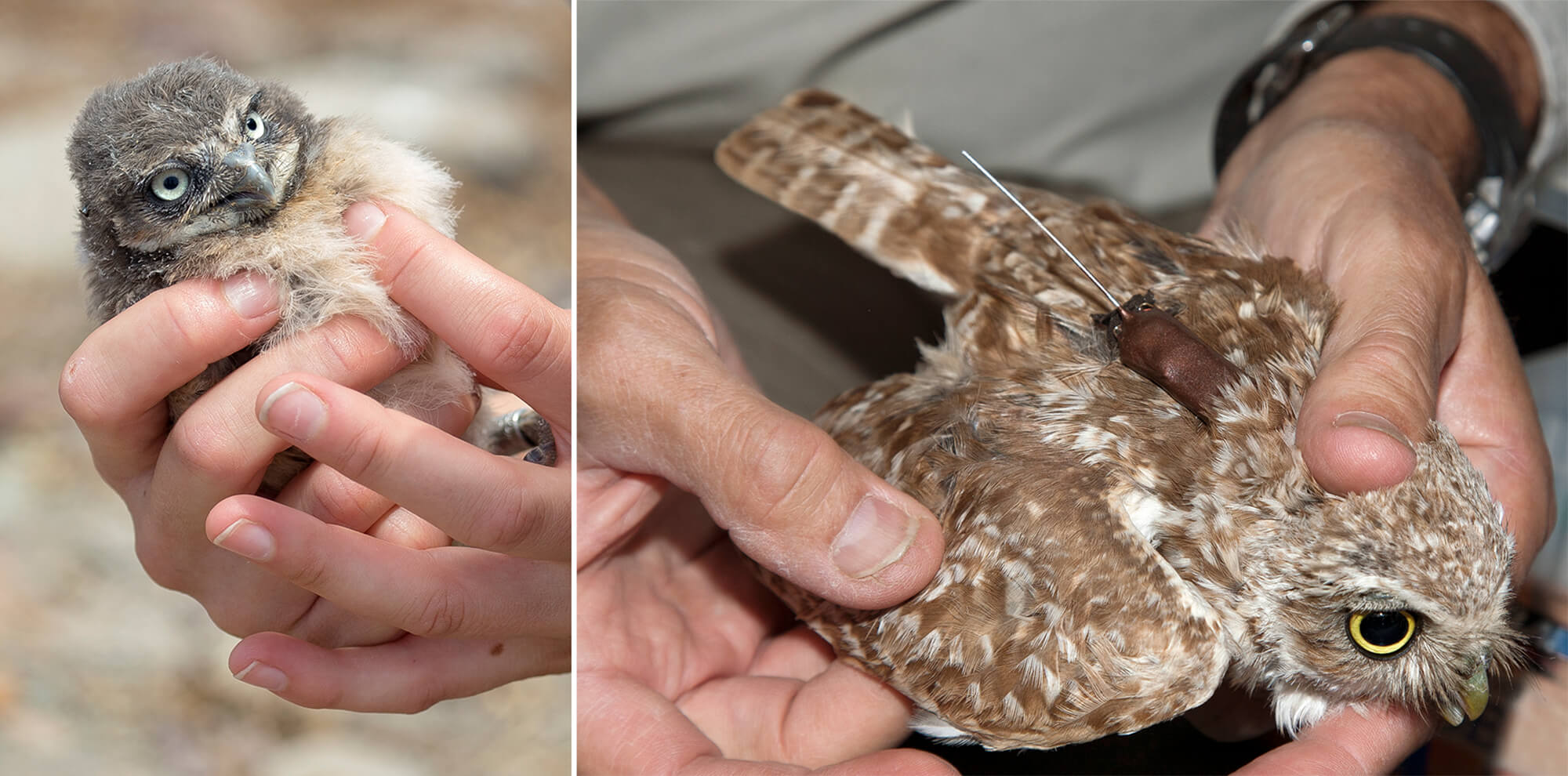
TAG, YOU’RE IT!
In addition to tags placed on the birds’ legs, which enable researchers to identify individuals, some birds get tiny “backpack” GPS telemetry trackers. This technology will show researchers where the birds travel and how they use their habitat. This information will allow land managers to best preserve habitat the birds need, and elucidate the best way to relocate owls in harm’s way.
Once widespread, the western burrowing owl is currently listed as a Species of Special Concern, largely due to habitat loss and fragmentation, as well as the eradication of ground squirrels, prairie dogs, and other fossorial animals, which excavate the burrows where the owls make their nests. (In a pinch, burrowing owls can dig their own burrow, but it could take several days, leaving them vulnerable to predators and the elements. It’s more efficient to be a “squatter” in an existing burrow and modify as needed.) According to the California Department of Fish and Wildlife, the San Diego population has been reduced to a single breeding node in the Otay Mesa region, just north of the Mexico border. A multi-agency effort is helping to re-establish the owls in diverse locations around the county, including breeding pairs at the San Diego Zoo Safari Park to be released next year.
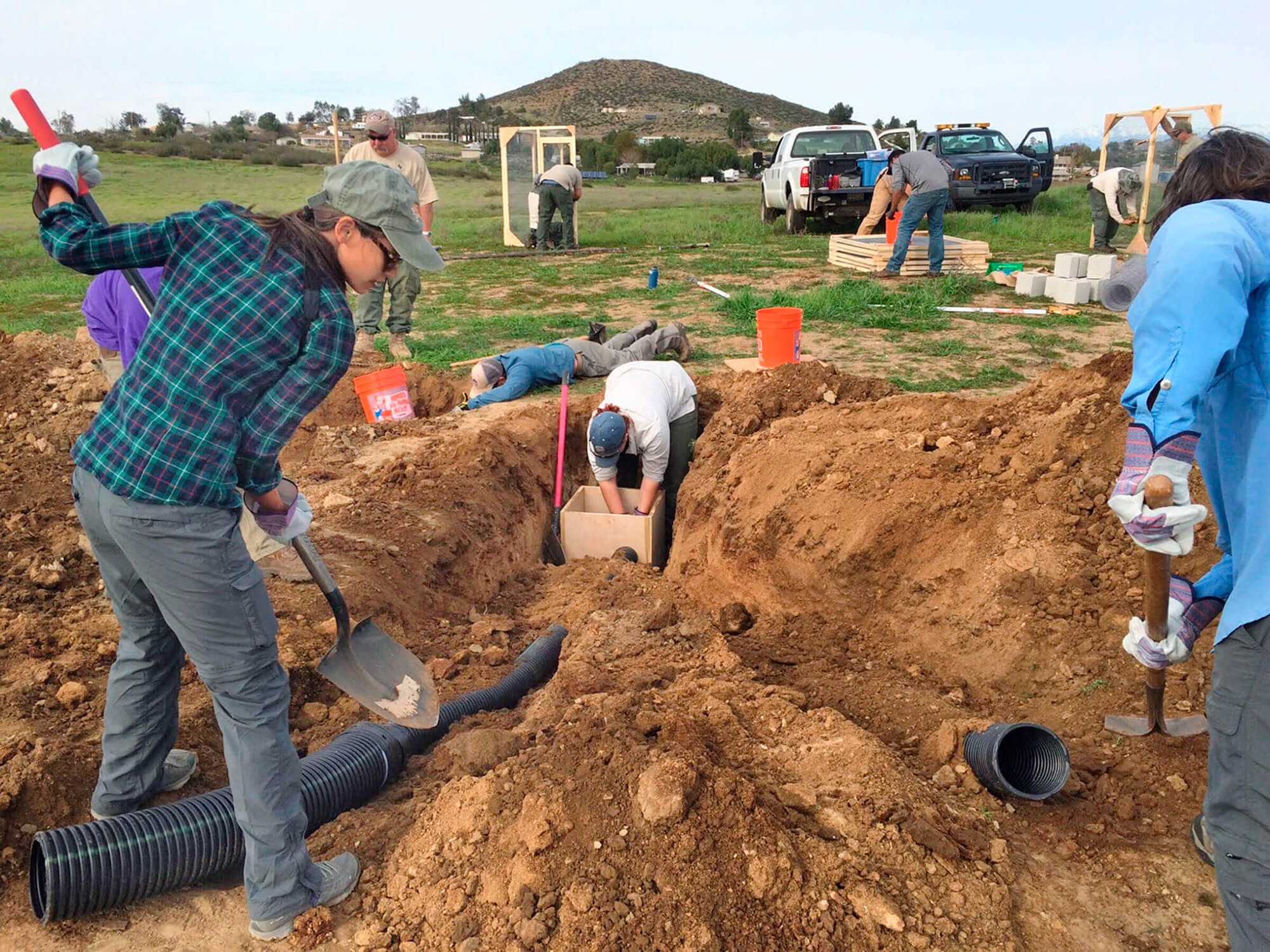
DIGGING CONSERVATION
Artificial burrow design has been refined to meet the owls’ needs. However, they require a great deal of time, money, and labor to maintain and manage. Natural burrows are an underground labyrinth with multiple chambers and exits.
Growing Up
 Back in the day, burrowing owls were often called “howdy birds,” because they appeared to nod a friendly greeting from their burrow entrance in so-called prairie dog towns.
Back in the day, burrowing owls were often called “howdy birds,” because they appeared to nod a friendly greeting from their burrow entrance in so-called prairie dog towns.
It takes teamwork (and a bit of luck) for a ground-dwelling owl species to successfully raise chicks. Though visible by day, burrowing owls are technically cathemeral, meaning they are active both day and night. A female lays 2 to 12 eggs (she can lay one egg per day), which she incubates for about one month, during which time the male hunts and brings food to her. As the eggs hatch, she dutifully dotes on them, and the male continues to bring food for her to disperse to their growing brood. After a week or two, the female joins in the hunting. Chicks may emerge from the burrow around two weeks of age, all downy and curious…and hungry. Soon they grow into their “fluffy and buffy” stage, a comical and playful butterball phase that entails practice “flights” and pouncing on things. By 45 days of age, they can sustain flight, though they still require parental training in survival skills. Adult birds are sexually monomorphic, meaning males and females look alike. But during the nesting season, while the females are busy inside the burrow for about six weeks, males stand guard and hunt outside the burrow, so their feathers may appear faded and sun-bleached.

OWL CAM INSTALLATION
To better understand burrowing owl ecology, researchers have installed motion-activated field cameras outside burrows. The photos will provide candid glimpses into their behavior, diet, brood rearing and survival. You can help classify the photos at WildwatchBurrowingOwl.org.
You can help San Diego Zoo Global save the burrowing owls of Southern California by classifying field photos of “The Gold Family,” burrowed in at Otay Mesa. The goal is to organize behaviors, predation, and survival of this burrowing owl family by noting what is happening in field photos. With internet access, you can log on to Wildwatch Burrowing Owl, take a quick tutorial, and start classifying images on the project. Each image set is viewed by 10 volunteers before it is “retired,” so avian expertise is not required—give it your best shot. You may be mesmerized by the high drama on the ground! For added inspiration, visit our live Burrowing Owl Cams at the Safari Park. You will get two perspectives: above ground in their exhibit, and a unique look into their burrow. Sometimes, it takes a village to save a species…and you are a vital part of that village.

